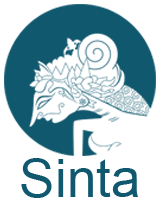Chemical, physical and organoleptic quality test of seaweed (Eucheuma cottonii) jelly candy with the addition of ginger juice and turmeric juice
Abstract
The rich potential of seaweed in Indonesian seas has been used to produce processed foods such as jelly candy, which is made from fruit juice and gelling agents. Jelly candy has a clear, transparent appearance and a certain chewy texture and is considered a semi-wet food. The aim of this study was to evaluate the effect of the addition of ginger and turmeric juice on the chemical, physical and organoleptic properties of seaweed jelly candy in order to make it acceptable to consumers. In this study, the results obtained showed that the jelly candy had a moisture content of 12%, a sugar content of 16% and a pH of 5.66. The addition of ginger juice and turmeric resulted in a colour lightness value of L* of 23.8 and ⁰Hue of 49.1. Organoleptically, the jelly candies scored positively in terms of colour, aroma, taste and texture. The colour of the jelly sweets received hedonic scores of 3.08 (liked) and 3.36 (brownish-yellow), aroma scores of 2.8 (liked) and 2.48 (less flavourful), taste scores of 2.84 (liked) and 2.56 (slightly ginger and turmeric flavour) and texture scores of 2.76 (liked) and 2.72 (chewy).
Keywords
Full Text:
PDFReferences
Ahmad, L., Une, S., & Bait, Y. (2019). Karakteristik Komponen Gizi, Antioksidan, dan Respon Organoleptik Bubur Jagung Tradisional Gorontalo dengan Ekstrak Daun Kersen (Muntingia calabura L.). AgriTECH, 38(4), 463. https://doi.org/10.22146/agritech.28670
Ali, F., Ferawati, & Arqomah, R. (2013). Ekstraksi Zat Warna dari Kelopak Bunga Rosella (Study Pengaruh Konsentrasi Asam Asetat dan Asam Sitrat). Jurnal Teknik Kimia, 19(1), 26–34.
Ariyati, R. W., Widowati, L. L., & Rejeki, S. (2016). Performa Produksi Rumput Laut Euchema cottonii yang Dibudidayakan Menggunakan Metode Long-line Vertikal dan Horisontal. Prosiding Hasil-Hasil Penelitian Perikanan Dan Kelautan, 332–346.
Ayuni Putri, D., Nur Hofifah, S., Adelina Putri, V., Doddy Pratama, & Doddy Pratama, M. (2021). Karakteristik Organoleptik Permen Jeli Jahe (Zingiber Officinale) dengan Variasi Takaran Jahe dan Jenis Pewarna Berbeda. Jurnal Teknologi Agro-Industri, 63–69.
Ermawati, D. E., Kundarto, W., & Farida, Y. (2022). Pengembangan Produk Permen Jelly Jamu Kunyit Asam Industri Rumah Tangga Jamu di Sleman Yogyakarta. Jurnal Pengabdian Pada Masyarakat, 7(2), 275–280. https://doi.org/10.30653/002.202272.56
Kurniasari, L., Hartati, I., & Ratnani, R. D. (2008). Kajian Ekstraksi Minyak Jahe Kadar Zingiberene Tinggi Dengan MAE. Momentum, 4(2), 47–52.
Marfungah, N., Tamrin, & Asyik, N. (2020). Karakteristik Kimia Dan Organoleptik Permen Jelly Daun Salam Abstract. Heliyon, 6(6), 1944–1956.
Misto, Mulyono, T., & Alex. (2016). Sistem Pengukuran Kadar Gula dalam Cairan menggunakan Sensor Fotodiode Terkomputerisasi. Jurnal ILMU DASAR, 17(1), 13–18.
Mochammad Arif Saputra, Noor Harini, & Rista Anggriani. (2020). Kajian Sifat Fisikokimia Permen Jelly oleh Tiga Varietas Jahe (Zingiberofficinale) dan Perbedaan Konsentrasi Ekstrak Karagenan dari Rumput Laut (Eucheuma cottoni). Food Technology and Halal Science Journal, 110–128.
Owusu-Apenten, R. (2004). Introduction to food chemistry. https://www.routledge.com/Introduction-to-Food-Chemistry/Owusu-Apenten/p/book/9780367393489
Ravi, R., Prakash, J., Pradeep, K., Ravi, R., & Madhava Naidu, M. (2016). Influence of blanching and drying methods on the quality characteristics of fresh turmeric (Curcuma longa l.) Rhizomes. International Journal of Aplied and Pure Science and Agriculture, 32–44. https://www.researchgate.net/publication/303630391
Rismandari, M., Agustini, T. W., Ulfah, D., Program, A., Teknologi, S., Perikanan, H., Perikanan, F., & Kelautan, I. (2017). Karakteristik Permen Jelly Dengan Penambahan Iota Karagenan Dari Rumput Laut Eucheuma Spinosum. Journal of Fisheries Science and Technology (IJFST) Saintek Perikanan, 12(2), 103–108.
Salamah, E., Erungan, A. C., & Yuni Retnowati, dan. (2006). Pemanfaatan Gracilaria sp. dalam Pembuatan Permen Jelly. Buletin Teknologi Hasil Perikanan, 39–48.
Setiawan, A. (2022). Keanekaragaman Hayati Indonesia: Masalah dan Upaya Konservasinya. Indonesian Journal of Conservation, 11(1), 13–21.
Sinurat, E., & Murniyati. (2014a). Pengaruh Waktu dan Suhu Pengeringan terhadap Kualitas Permen Jeli. JPB Perikanan, 133–142.
Sinurat, E., & Murniyati, M. (2014b). Pengaruh Waktu dan Suhu Pengeringan terhadap Kualitas Permen Jeli. Jurnal Pascapanen Dan Bioteknologi Kelautan Dan Perikanan, 9(2), 133. https://doi.org/10.15578/jpbkp.v9i2.106
Tarwendah, I. P. (2017). Jurnal Review: Studi Komparasi Atribut Sensoris dan Kesadaran Merek Produk Pangan. Jurnal Pangan Dan Agro Industri, 5(2), 66–73.
Tresna Yuliawaty, S., & Susanto, W. H. (2015). Pengaruh Lama Pengeringan dan Konsentrasi Maltodekstrin Terhadap Karakteristik Fisik danKimia dan Organoleptik Minuman Mengkudu (Morinda citrifolia L). In dkk Jurnal Pangan dan Agroindustri (Vol. 3).
Ulfah, M. (2011). Pengaruh Konsentrasi Larutan Asam Asetat Dan Lama Waktu Perendaman Terhadap Sifat-Sifat Gelatin Ceker Ayam. Agritech, 31(3).
DOI: https://doi.org/10.31764/jafp.v3i1.13554
Refbacks
- There are currently no refbacks.
Copyright (c) 2023 Setiawati & ginger; jelly candy; seaweed; turmeric

This work is licensed under a Creative Commons Attribution-ShareAlike 4.0 International License.
JAFP is indexing in the following databases:











